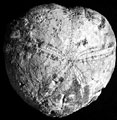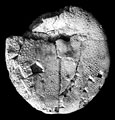The Echinoid Directory
Contributed by Dinesh Srivastava, March 2010
Megapneustes jaisalmerensis Srivastava et al., 2008; p. 32
| Diagnostic Features |
|
|---|---|
| Distribution | Early Eocene, Rajasthan, India. |
| Type | Holotype: GU/R/KE/2023; Paratype Nos. GU/R/KE /2024 to GU/R/KE/2026 and GU/R/KE /F 2027-31; Laboratory of Vertebrate Palaeontology, Department of Geology, HNB Garhwal University, Srinagar (Garhwal), Uttaranchal, India. |
| Classification and/or Status | Order Spatangoida Claus, 1876; Family Brissidae Gray, 1855. A species of Megapneustes Gauthier, 1899 |
| Remarks | Megapneustes jaisalmerensis is close to the M. grandis Gauthier, 1899 from the Eocene of Egypt (Gauthier, 1899) but differs from the latter in having a heart shaped test, monobasal apical system, long, subpetaloid, ambulacral petals which reach almost up to the ambitus whereas the Egyptian species has an oval test with straight ambulacral petals which do not reach to the ambitus and a tetrabasal apical system. Gauthier in Fourtau, R. 1899. Revision des echinides fossiles de l'Egypte. Memoires de l'Institut egyptien, 3(8), 605-740, pls 1-4. Srivastava, D. K., Rana, R. S. & Hukam Singh, 2008. Record of Megapneustes Gauthier (brissid echinoid) from the Khuiala Formation, Jaisalmer district, Rajasthan, India. Journal of the Palaeontolgical Socity of India 53, 31-36. |





